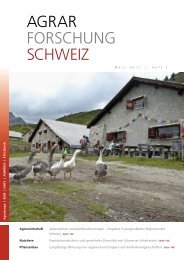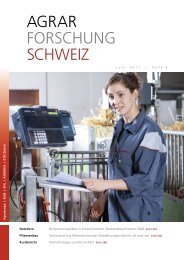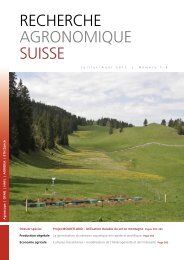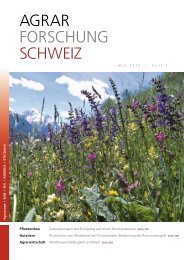Download als PDF - Agrarforschung Schweiz
Download als PDF - Agrarforschung Schweiz
Download als PDF - Agrarforschung Schweiz
Erfolgreiche ePaper selbst erstellen
Machen Sie aus Ihren PDF Publikationen ein blätterbares Flipbook mit unserer einzigartigen Google optimierten e-Paper Software.
Kurze Flugdistanzen zwischen Nist- und Nahrungs habitaten fördern eine reiche Wildbienenfauna | Umwelt<br />
Riassunto<br />
Distanze brevi tra il luogo di nidificazione e le<br />
zone di bottinatura favoriscono le api selvatiche<br />
Le api selvatiche sono impollinatori indispensabili<br />
della flora selvatica e coltivata. Esse ricoprono anche<br />
un ruolo importante sul piano ecologico ed economico.<br />
Circa metà delle 600 specie d’api selvatiche presenti in<br />
Svizzera sono minacciate. Il crescente sfruttamento<br />
delle superfici e l’intensificazione dell’agricoltura<br />
riducono gli ambienti adatti alla nidificazione e alla<br />
bottinatura. Le api devono quindi percorrere distanze<br />
sempre maggiori per raccogliere nettare e polline.<br />
Questo studio mira a determinare la distanza massima<br />
che alcune specie d’api selvatiche riescono a percorrere<br />
per la bottinatura e ad analizzare l’impatto delle crescenti<br />
distanze sulla riproduzione. Delle specie d’api<br />
selvatiche, strettamente infeudate a un genere di<br />
piante, sono state poste in un ambiente privo di<br />
appropriate piante ospite, inducendole a bottinare su<br />
specie in vaso poste a diverse distanze dagli alveari.<br />
Alcuni individui delle specie Hoplitis adunca e Hylaeus<br />
punctulatissimus hanno percorso lunghe distanze,<br />
superando i 1000 metri, tra il nido e la pianta nutritrice.<br />
La maggior parte degli individui ha abbandonato<br />
l’attività di nidificazione già quando la distanza era tra<br />
i 100 – 300 metri. L’aumentare delle distanze di<br />
bottinatura sembra quindi comportare costi elevati.<br />
A partire da una distanza di 150 metri, la capacità riproduttiva<br />
è sostanzialmente ridotta, sia per individui<br />
della specie Hoplitis adunca che per quelli della specie<br />
Chelostoma rapunculi. Distanze brevi tra il sito di<br />
nidificazione e zone di bottinatura potrebbero<br />
contribuire considerevolmente a favorire la diversità<br />
delle specie e la crescita delle popolazioni di api<br />
selvatiche.<br />
Summary<br />
Close neighbourhood of nesting sites and foraging<br />
habitats enhances a diverse fauna of native bees<br />
Native bees are essential pollinators of wild and crop<br />
plants providing high ecological and economical<br />
benefits. However, half of the 600 native bee species<br />
of Switzerland are endangered. Ongoing soil sealing<br />
and intensification of agricultural land use result in<br />
fewer suitable nesting sites and foraging habitats,<br />
which is expected to force female bees to cover<br />
longer distances between nest and flower-rich<br />
patches. In this study, maximum foraging distances<br />
of selected solitary bee species were investigated<br />
and the effect of increasing foraging distances on<br />
their reproduction was analyzed. Bee species, which<br />
restrict pollen foraging to a single plant genus, were<br />
established in an agricultural landscape lacking their<br />
specific host plants. Females were forced to collect<br />
pollen on potted host plants at different distances<br />
from their nests. Only few individu<strong>als</strong> of Hoplitis<br />
adunca and Hylaeus punctulatissimus covered long<br />
distances of more than 1000 m to collect pollen. The<br />
majority of females already discontinued foraging at<br />
a distance of 100 – 300 m, which indicates that long<br />
distances between nesting sites and flower resources<br />
impose high costs on reproduction. In fact, increased<br />
distances by 150 m and more substantially reduced<br />
the number of progeny produced by females of<br />
Hoplitis adunca and Chelostoma rapunculi. Thus, a<br />
close neighbourhood of nesting and foraging<br />
habitats clearly contributes to a diverse native bee<br />
fauna and to an increase of bee population sizes.<br />
Key words: foraging distance, bee conservation,<br />
fitness cost, habitat fragmentation.<br />
Literatur<br />
▪▪<br />
Amiet F., 1994. Rote Liste der gefährdeten Bienen der <strong>Schweiz</strong>. In: Rote<br />
Listen der gefährdeten Tierarten in der <strong>Schweiz</strong>. (Ed. P. Duelli). BUWAL,<br />
Bern, 38 – 44.<br />
▪▪<br />
Gathmann A. & Tscharntke T., 2002. Foraging ranges of solitary bees.<br />
Journal of Animal Ecology 71,757 – 764.<br />
▪▪<br />
Goodell K., 2003. Food availability affects Osmia pumila (Hymenoptera:<br />
Megachilidae) foraging, reproduction, and brood parasitism. Oecologia<br />
134, 518 – 527.<br />
▪▪<br />
Greenleaf S.S., Williams N.M., Winfree R. & Kremen C., 2007. Bee foraging<br />
ranges and their relationship to body size. Oecologia 153, 589 – 596.<br />
▪▪<br />
Müller A., Diener S., Schnyder S., Stutz K., Sedivy C. & Dorn S., 2006.<br />
Quantitative pollen requirements of solitary bees: Implications for bee<br />
conservation and the evolution of bee-flower relationships. Biological<br />
Conservation 130, 604 – 615.<br />
▪▪<br />
Neff J.L., 2008. Components of nest provisioning behavior in solitary<br />
bees (Hymenoptera: Apoidea). Apidologie 39, 30 – 45.<br />
▪▪<br />
Peterson J.H. & Roitberg B.D., 2006. Impacts of flight distance on sex ratio<br />
and resource allocation to offspring in the leafcutter bee, Megachile<br />
rotundata. Behavioral Ecology and Sociobiology 59, 589 – 596.<br />
▪▪<br />
Schmid-Hempel P. & Wolf T., 1988. Foraging effort and life-span of<br />
workers in a social insect. Journal of Animal Ecology 57, 509 – 521.<br />
▪▪<br />
Seidelmann K., 2006. Open-cell parasitism shapes maternal investment<br />
patterns in the Red Mason bee Osmia rufa. Behavioral Ecology 17,<br />
839 – 848.<br />
▪▪<br />
Torchio P.F. &. Tepedino V.J., 1980. Sex-ratio, body size and seasonality<br />
in a solitary bee, Osmia lignaria propinqua Cresson (Hymenoptera: Magachilidae).<br />
Evolution 34, 993 – 1003.<br />
▪▪<br />
Williams N.M. & Kremen C., 2007. Resource distributions among habitats<br />
determine solitary bee offspring production in a mosaic landscape.<br />
Ecological Applications 17, 910 – 921.<br />
▪▪<br />
Zurbuchen A., Cheesman S., Klaiber J., Müller A., Hein S. & Dorn S.,<br />
2010a. Long foraging distances impose high costs on offspring production<br />
in solitar bees. Journal of Animal Ecology 79, 674 – 681.<br />
▪▪<br />
Zurbuchen A., Landert L., Klaiber J., Müller A., Hein S. & Dorn S., 2010b.<br />
Maximum foraging ranges in solitary bees: only few individu<strong>als</strong> have the<br />
capability to cover long foraging distances. Biological Conservation 143,<br />
669 – 676.<br />
<strong>Agrarforschung</strong> <strong>Schweiz</strong> 1 (10): 360–365, 2010<br />
365
















